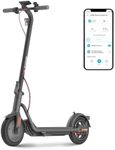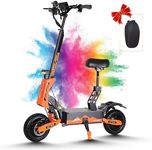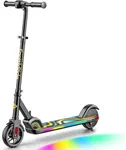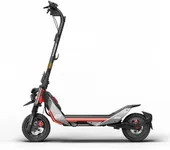Buying Guide for the Best Waterproof Electric Scooter For Adults
Choosing a waterproof electric scooter for adults can be a smart move if you plan to ride in different weather conditions or want extra durability. The right scooter should match your daily needs, whether it's for commuting, leisure, or running errands. It's important to look beyond just the waterproof label and consider how the scooter's features fit your lifestyle, riding habits, and local environment. Understanding the key specifications will help you make a confident and informed decision.Waterproof Rating (IP Rating)The waterproof rating, often shown as an IP (Ingress Protection) rating, tells you how well the scooter can resist water and dust. This is important because it determines whether you can safely ride in rain or through puddles without damaging the electronics. IP ratings usually look like 'IP54' or 'IP67.' The first number is for dust protection, and the second is for water. For example, IP54 means the scooter is protected against splashes, while IP67 means it can handle being submerged for a short time. If you only expect light rain, IP54 or IP55 is usually enough. For heavy rain or very wet conditions, look for IP66 or higher. Think about your local weather and how often you'll ride in wet conditions to choose the right level of protection.
Motor PowerMotor power, measured in watts (W), affects how fast the scooter can go and how well it handles hills or heavy loads. This is important because a more powerful motor can make your ride smoother and more enjoyable, especially if you have to climb hills or carry extra weight. Scooters typically range from 250W to over 1000W. For flat city streets and lighter riders, 250W to 350W is usually enough. If you expect to ride on hilly terrain or want faster acceleration, consider 500W or more. Match the motor power to your typical routes and how much performance you want.
Battery RangeBattery range tells you how far the scooter can travel on a single charge. This is important because it determines how often you'll need to recharge and whether the scooter can handle your daily trips. Ranges can vary from about 10 miles to over 40 miles. If you only need the scooter for short commutes or errands, a lower range may be fine. For longer rides or if you don't want to charge often, look for a higher range. Think about your daily travel distance and add a little extra for unexpected detours.
Weight CapacityWeight capacity is the maximum load the scooter can safely carry, including the rider and any cargo. This is important for safety and performance, as exceeding the limit can damage the scooter or reduce its efficiency. Most adult scooters support between 220 to 300 pounds. Choose a scooter with a weight limit that comfortably covers your body weight plus anything you might carry, like a backpack or groceries.
Tire Type and SizeTire type and size affect ride comfort, stability, and how well the scooter handles wet or rough surfaces. There are solid tires (puncture-proof but less cushioned) and pneumatic (air-filled) tires (better shock absorption but can get flats). Larger tires (8.5 inches or more) generally provide a smoother ride and better grip, especially in wet conditions. If you ride on bumpy roads or in the rain, consider larger, air-filled tires. For smoother, dry surfaces, solid tires may be enough and require less maintenance.
Braking SystemThe braking system is crucial for safety, especially in wet conditions. Common types include electronic, disc, and drum brakes. Disc brakes usually offer the best stopping power, even when it's wet, while electronic brakes are low-maintenance but may not be as strong. If you often ride in the rain or need quick stops, look for scooters with disc or drum brakes. For mostly dry, flat routes, electronic brakes may be sufficient.
Portability (Weight and Folding Mechanism)Portability refers to how easy it is to carry or store the scooter, which depends on its weight and whether it folds. This is important if you need to take the scooter on public transport, store it in a small space, or carry it upstairs. Lighter scooters (under 30 pounds) are easier to handle, but may have fewer features. Heavier scooters can be more powerful but harder to carry. Consider how often you'll need to lift or store the scooter and choose a weight and folding design that fits your routine.









